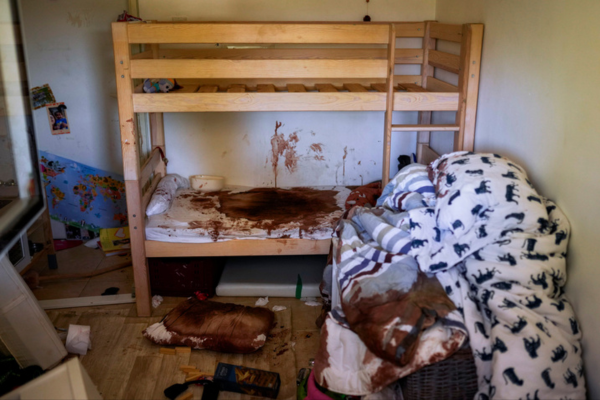Days before a trip to Poland, a holocaust came upon the residents of Nir Oz.
By Andrew Tobin, The Washington Free Beacon
Ola Metzger, 45, had planned to send her daughter on a Holocaust education trip to Poland. But on Oct. 7, days before the trip was to depart, a holocaust came to them.
Early that morning, hundreds of heavily armed shock troops from the Gaza Strip stormed their kibbutz, Nir Oz, slaughtering, burning, and rounding up Jews. About one in four of the some 400 members of the community were killed or taken hostage.
“I told her to hide under the bed because bad guys were out there shooting all over, all around,” Metzger said in an interview with the Washington Free Beacon. “And all I was thinking [was] what happens if they get in?”
Regarding the trip to Poland, a traditional rite of passage in which Israeli high schoolers visit Auschwitz and other Nazi camps, Metzger said her daughter “doesn’t need to go now.”
Just as tens of thousands of German civilians willingly joined in the Nazis’ extermination of six million Jews, masses of ordinary Gazans flooded into Israel on Oct. 7 behind the Hamas terrorists who led the surprise assault. Footage from a number of the targeted communities shows dozens of ordinary-looking Gazans looting and taking part in killings and kidnappings of Israelis.
“The second wave of Arabs who came into the country were just as cruel as the terrorists of the first wave,” Gadi Yarkoni, the mayor of the Eshkol Regional Council, which encompasses most of the Gaza border communities, told the Free Beacon in October. “We saw that it was not only Hamas who came to slaughter us. It was all the residents of Gaza, including people who worked in our kibbutzim.”
In Niz Oz, Gazan women and children as young as 10 years old participated in the pogrom on Oct. 7, according to a dozen survivors.
“Basically it was sort of an invasion of a community,” Irit Lahav, a 57-year-old tour guide and peace activist from the kibbutz, told the Free Beacon. “That’s why for me, I cannot say this was a Hamas action. No, for me, this was a Palestinian action. A whole community had come to our kibbutz, took our things, stole stuff, killed people, and kidnapped others.”
Oct. 7 was the deadliest day for Jews since World War II, with some 1,200 people killed, most of them civilians, and 240 others abducted to Gaza. Almost half of the hostages have been since released during Israel’s ongoing war against Hamas, including 30 who were taken from Nir Oz.
Metzger, who hid in her safe room with her family on Oct. 7, heard two looters in the house who sounded like they were about the age of her 13-year-old son. Terrorists had already burned down many of her neighbors’ homes, she noted, killing three young children and their parents next door.
“Whoever was in my neighborhood saw all that,” she said. “And still these kids were in my son’s room, stealing his PlayStation and his soccer shoes and whatever else.”
For Metzger, like many other liberal-minded kibbutzniks who survived Oct. 7, the experience destroyed her belief in the decency of the Gazan people.
“I can’t believe that these actions can be real actions to aim to free Palestine from someone. So the hate is there towards us,” she said. “It’s very harsh to say that I hate someone, but I don’t trust anyone now. I don’t trust them. I can’t. We lost so many people.”
A Jewish immigrant from Kyrgyzstan, Metzger said her grandfather was Muslim and she was raised to believe “religion shouldn’t matter.” But she said the brand of Islam that has taken root in Gaza “should be brought down as soon as possible.”
“I hope the world understands that. I’m not sure, though,” she said. “If the Jews are not safe in Israel, I don’t think the Jews can feel safe anywhere.”
